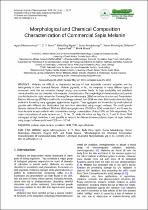 ResearchSpace
ResearchSpace
Morphological and chemical composition characterization of commercial sepia melanin
JavaScript is disabled for your browser. Some features of this site may not work without it.
- ResearchSpace
- →
- Research Publications/Outputs
- →
- Journal Articles
- →
- View Item
| dc.contributor.author |
Mbonyiryivuze, A

|
|
| dc.contributor.author |
Nuru, ZY

|
|
| dc.contributor.author |
Ngom, BD

|
|
| dc.contributor.author |
Mwakikunga, Bonex W

|
|
| dc.contributor.author |
Dhlamini, SM

|
|
| dc.contributor.author |
Park, E

|
|
| dc.contributor.author |
Maaza, M

|
|
| dc.date.accessioned | 2016-06-27T07:54:52Z | |
| dc.date.available | 2016-06-27T07:54:52Z | |
| dc.date.issued | 2015-06 | |
| dc.identifier.citation | Mbonyiryivuze, A. Nuru, Z.Y. Ngom, B.D. Mwakikunga, B. Dhlamini, S.M. Park, E. and Maaza, M. 2015. Morphological and chemical composition characterization of commercial sepia melanin. American Journal of Nanomaterials, 3(1), 22-27 | en_US |
| dc.identifier.issn | 2372-3114 | |
| dc.identifier.uri | http://pubs.sciepub.com/ajn/3/1/3/ | |
| dc.identifier.uri | http://hdl.handle.net/10204/8560 | |
| dc.description | Copyright: 2015 Science and Education Publishingr. Due to copyright restrictions, the attached PDF file only contains the abstract of the full text item. For access to the full text item, please consult the publisher's website. The definitive version of the work is published in American Journal of Nanomaterials, 3(1), 22-27 | en_US |
| dc.description.abstract | Melanins are difficult to characterize because of their intractable chemical properties and the heterogeneity in their structural features. Melanin pigments, in fact, are composed of many different types of monomeric units that are connected through strong carbon-carbon bonds. Its high insolubility and undefined chemical entities are two obstacles in its complete characterization. The morphological characterization and particle size distribution for sepia melanin by Scanning Electron Microscopy (SEM) on surface structure and Transmission Electron Microscopy (TEM) to confirm the morphology obtained from SEM was done. Both results show that Sepia melanin is formed by many aggregates agglomerated together. These aggregates are formed also by small spherical granules with different size distributions that have been determined using image-J software. The small granule diameter obtained from different TEM and SEM micrographs were 100-200nm. EDS reveals that C and O were the most abundant in sepia melanin with concentration average concentrations of about 57% and 24% respectively. The major compositions of sepia melanin are C, O, Na, Cl, while the minor are Mg, Ca, K, S and N. From TEM micrograph at high resolution, it was possible to measure the distance between polymers layers of sepia melanin using image-J software and it was 0.323 nm = 3.23 A°. | en_US |
| dc.language.iso | en | en_US |
| dc.publisher | Science and Education Publishing | en_US |
| dc.relation.ispartofseries | Workflow;16343 | |
| dc.subject | Melanin | en_US |
| dc.subject | Sepia melanin | en_US |
| dc.subject | Eumelanin | en_US |
| dc.subject | Scanning Electron Microscopy | en_US |
| dc.subject | SEM | en_US |
| dc.subject | Transmission Electron Microscopy | en_US |
| dc.subject | TEM | en_US |
| dc.subject | Sepia officinalis | en_US |
| dc.title | Morphological and chemical composition characterization of commercial sepia melanin | en_US |
| dc.type | Article | en_US |
| dc.identifier.apacitation | Mbonyiryivuze, A., Nuru, Z., Ngom, B., Mwakikunga, B. W., Dhlamini, S., Park, E., & Maaza, M. (2015). Morphological and chemical composition characterization of commercial sepia melanin. http://hdl.handle.net/10204/8560 | en_ZA |
| dc.identifier.chicagocitation | Mbonyiryivuze, A, ZY Nuru, BD Ngom, Bonex W Mwakikunga, SM Dhlamini, E Park, and M Maaza "Morphological and chemical composition characterization of commercial sepia melanin." (2015) http://hdl.handle.net/10204/8560 | en_ZA |
| dc.identifier.vancouvercitation | Mbonyiryivuze A, Nuru Z, Ngom B, Mwakikunga BW, Dhlamini S, Park E, et al. Morphological and chemical composition characterization of commercial sepia melanin. 2015; http://hdl.handle.net/10204/8560. | en_ZA |
| dc.identifier.ris | TY - Article AU - Mbonyiryivuze, A AU - Nuru, ZY AU - Ngom, BD AU - Mwakikunga, Bonex W AU - Dhlamini, SM AU - Park, E AU - Maaza, M AB - Melanins are difficult to characterize because of their intractable chemical properties and the heterogeneity in their structural features. Melanin pigments, in fact, are composed of many different types of monomeric units that are connected through strong carbon-carbon bonds. Its high insolubility and undefined chemical entities are two obstacles in its complete characterization. The morphological characterization and particle size distribution for sepia melanin by Scanning Electron Microscopy (SEM) on surface structure and Transmission Electron Microscopy (TEM) to confirm the morphology obtained from SEM was done. Both results show that Sepia melanin is formed by many aggregates agglomerated together. These aggregates are formed also by small spherical granules with different size distributions that have been determined using image-J software. The small granule diameter obtained from different TEM and SEM micrographs were 100-200nm. EDS reveals that C and O were the most abundant in sepia melanin with concentration average concentrations of about 57% and 24% respectively. The major compositions of sepia melanin are C, O, Na, Cl, while the minor are Mg, Ca, K, S and N. From TEM micrograph at high resolution, it was possible to measure the distance between polymers layers of sepia melanin using image-J software and it was 0.323 nm = 3.23 A°. DA - 2015-06 DB - ResearchSpace DP - CSIR KW - Melanin KW - Sepia melanin KW - Eumelanin KW - Scanning Electron Microscopy KW - SEM KW - Transmission Electron Microscopy KW - TEM KW - Sepia officinalis LK - https://researchspace.csir.co.za PY - 2015 SM - 2372-3114 T1 - Morphological and chemical composition characterization of commercial sepia melanin TI - Morphological and chemical composition characterization of commercial sepia melanin UR - http://hdl.handle.net/10204/8560 ER - | en_ZA |





